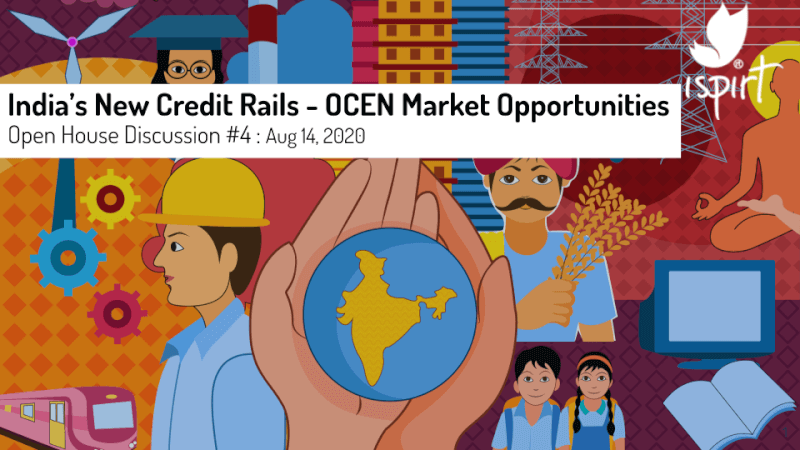On 14th August we hosted the fourth open house session on Open Credit Enablement Network (OCEN). This week’s discussion focused on the different roles and market opportunities for ecosystem participants across the lending value chain.
To recap, OCEN (O-Ken) is a new paradigm for credit that seeks to provide a common language for lenders and marketplaces to build innovative, financial credit products at scale.
In last week’s session, we did a deep dive into the underlying OCEN API flows, covering different entity interactions in-depth and addressing common technical queries.
We began by highlighting the shift from balance sheet based lending to cash flow based lending that will be enabled by OCEN adoption. This upgraded methodology gives lenders a more holistic way to assess the creditworthiness of potential borrowers while allowing for more innovation in the kinds of products that can be offered to individuals and MSMEs.
OCEN is built around the idea that any service provider that interfaces with consumers and MSMEs can become a Fintech-enabled credit marketplace i.e. a Loan Service Provider. A key component to the success of this approach is that data from these digital platforms will reduce the information asymmetry between borrower and lender.
There is room for entities to play the role of Derived Data Providers by digesting this data (after obtaining user consent) and helping to inform the lender’s credit rules. Working alongside specialised Underwriting Modellers, these players can map the best the fit between lender and borrower, making for smarter underwriting.
OCEN is designed to enable many types of LSPs offering diverse ‘species’ of credit products. While the last three sessions have focused on MSME credit, this week our volunteers covered several use cases for individual consumers and service professionals. Principally these resemble the ‘Type 4’ loan products highlighted in earlier sessions where the end use for the loan is defined, and the repayment is locked into incoming cash flows.
Through the past few weeks one of our objectives has been to illuminate the range of opportunities for participants (both new and incumbent) to get involved in an OCEN-enabled lending process. Entities can provide value by bringing superior distribution, data, technology, or capital into the equation.
LSPs have an important role to play as ‘agents of the borrower’. Technology Service Providers (TSP) need to work with lenders, LSPs or both, helping them to successfully come onboard the OCEN protocol. Account Aggregators play the role of data fiduciaries, facilitating the consented sharing of financial information in real time. Payment Service Providers (PSP) provide a ready infrastructure for both the disbursement of loans and collection of repayments.
Even incumbent fintech lending marketplaces that have a ‘deep, tacit know-how of the lending domain’ can play multiple roles in the cash flow based lending value chain.
Finally, our volunteers talked about CredAll, which is a collective of lending ecosystem players to drive cash flow based lending. Participants interested in becoming an OCEN-enabled Lender or LSP can have a look through the suggested checklist and basic requirements for each.
The fourth session on OCEN covered the following topics broadly, and the entire webinar is also available on our official Youtube channel:
- By Siddharth Shetty
- An introduction to iSPIRT and our values
- By Nipun Kohli
- New cash flow based lending paradigm
- Derived data providers
- How DDPs and Underwriting Modellers can help assess the creditworthiness of potential borrowers
- Types of lending products enabled by OCEN
- Product example 1 (Consumer finance use cases like paying school fees or streaming charges)
- Product example 2 (For service professionals)
- By Ankit Singh
- Opportunities for different stakeholders at various stages in the credit lifecycle
- Different ways entities can add value
- How an LSP is different from a DSA
- 5 D’s of value addition for LSPs
- The role of Technical Service Providers (TSP), Account Aggregators (AA), and Payment Services Providers (PSP)
- OCEN opportunity for incumbent fintech lending players
- How to become an OCEN-enabled lender or LSP
After the presentation, our volunteers answered some questions from the community including:
- How to think about constructing the right business models for LSPs and lenders?
- Does a DDP always have to be an LSP?
- What are the opportunities for existing fintech players?
- What are the KYC implications for OCEN?
As always, in order to successfully create a new credit ecosystem for Bharat it will take the collaborative effort of participants from every corner of our fintech ecosystem.
If you’re interested in participating as a:
- Loan Service Provider
- Lender
- Technology Service Provider
please drop us an email at community@ispirt.in
Readers may also submit any questions about the OCEN to the same email address and our anchor volunteers shall try their best to answer these questions during next open house discussion (P.S: Time and Date is yet to be decided)
If you would like to know more about becoming an LSP, please check out www.credall.org (CredAll is a collective of lending ecosystem players to drive cash flow based lending)
Recommended Reading:
Chapter 7 and 8 in RBI UK Sinha MSME committee report: https://www.rbi.org.in/Scripts/PublicationReportDetails.aspx?UrlPage=&ID=924
Introduction to India Stack’s fourth layer – Data Empowerment & Protection Architecture: https://www.youtube.com/watch?v=mW__azI8_ow


